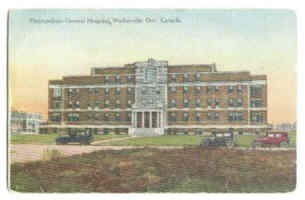| Based on The History of the Metropolitan General Hospital Auxiliary: sixty Years of Dedication, 1934-1994 by David Williamson

The Metropolitan General Hospital Aid, as the Auxiliary was initially known, was organized on May 16, 1934. Its creation was stimulated by both the governing body of the hospital and other interested individuals. During the initial meeting, officers were chosen, committees were organized, an advisory board was formed and meeting dates and times were set. Then, the women set to the task of raising money and in their first year, a total of $416 was given to the hospital.
In the early years, the Auxiliary hosted a variety of fundraising activities: the annual tea, bridge parties, rummage sales, a musical comedy, and the sale of jam and jellies. Sewing and the marking of hospital linens also played a large part in the Auxiliary’s early activities. Significant purchases included pictures and reading material for the children’s ward and other patients and a Bronchoscope, which was subsequently made available to the other hospitals in the city. World War II had a drastic impact on the nature of fundraising. The Auxiliary collected salvageable materials [tin, tinfoil, glass, cotton, clothes hangers] for sale, canning and preserving were limited due to a lack of Certo and sugar, and tea was not served at the meetings in an effort to conserve resources. Post-war fundraising activities took a new turn with the advent of a new, popular event – an annual fair.
From the opening of the School of Nursing at Metropolitan General Hospital in 1949 until its closure in 1974, the Auxiliary made a significant contribution. It hosted parties, occasionally helped financially needy students, provided prizes, gifts, a scholarship, and entertainment, and helped to furnish a place of relaxation. Perhaps most importantly, they helped to host the graduation ceremonies, providing the nurses with corsages, pins, and diploma covers.
The 1950s brought an increase in membership and the establishment of a Junior Group [later known as the Evening Auxiliary] which was made up of younger women who were unavailable for duty during the day. They played an important role in the history of the Auxiliary, being responsible for the opening of the Hospitality [Gift] Shop. By 1959, when the group celebrated its twenty-fifth anniversary, contributions to the hospital in one form or another had exceeded $80,000.
Social gatherings were no longer the best way to raise the money needed in an increasingly expensive and expanding healthcare system. Accordingly, the 1960s are marked by new ventures on the part of the Auxiliary. In April of 1960, the group started its hospitality cart service, wheeling the cart around to the wards to provide shopping opportunities for bed-ridden patients. By 1962, the importance of the cart became evident as it replaced the annual fair as the group’s prime fundraiser and the fair was phased out in 1966. After much discussion and planning, the Gift Shop was opened in October of 1963. The following March, the selling of baby pictures was introduced in the maternity ward. That same month, the Junior Group was amalgamated with the regular Auxiliary.
An expansion of services was the natural outgrowth of an increase in funds raised by the Auxiliary during the 1970’s. Within a span of a few short years, many changes occurred which again, demonstrated the group’s ability and willingness to keep itself viable and integral to community service. In 1973, the coffee shop was opened as a new and different source of income. The year also brought a touch of sadness as it was the final year for student nursing classes at the Hospital. By 1974, it was decided to discontinue the library cart service. To counter that, however, the significant impact that the Auxiliary had on the hospital was brought into sharp focus when the Intensive Care Unit was totally equipped through the efforts of the group. The following year saw the start of both the hairdressing shop and the Escort Service which provided patients with assistance during admitting and departure procedures. Also in 1975, the Auxiliary purchased heart telemetry monitoring units which were instantly put to constant use.
The Auxiliary continued to expand its range of service throughout the 1980s and ’90s. Throughout the early 1990s, Gift Shop sales were averaging $1,000.00 a day. The amalgamation of hospitals had a large impact on volunteer services, with Windsor Western Campus, Malden Park, and the Metropolitan Campus requiring a new level of coordinated volunteerism. Café Met was closed in 1996 which dealt a blow to volunteer fundraising efforts. This was countered by the building of a new Gift Shop in conjunction with a major building plan at the hospital. There was more participation in inpatient care and rehabilitation, and in helping staff with time-consuming but ultimately important day-to-day tasks. In the spirit of teamwork and coordinated effort, a gala was held in 1999 for hospital volunteers from all Windsor hospitals. Massive funds were pledged towards the Together in Caring fundraising campaign. The Auxiliary also supported the Clown Doctor Program which began at the Metropolitan Campus. As a result of hospital services moving and merging, the Auxiliary has been indispensable at a new Help Desk which assists patients and their families or visitors with their questions.
The Metropolitan General Hospital Auxiliary has had a history of community service distinguished by tireless service and significant contribution. It has raised hundreds of thousands of dollars which in turn has improved the quality of life for countless patients. This year, as it celebrates its 70th anniversary, it can be proud of all it’s done and know that the people of Windsor and the surrounding area owe it a huge debt of gratitude.
|